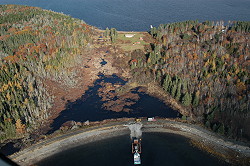
Photo. The dam with the point X - borehole 10x- on the treasure island in Canada, Oak Island.
© Petter Amundsen, Norway.
It’s more to the picture than the eyes have seen so far? There is also a theory indicating that the Oak Island constructions are connected with another island. Just like the Da Vinci Code, the Oak Island mystery is an amazing thriller where people have to use their brains at the fullest. As written about in this book there are lost books (gospels) of the Bible. We read in The Da Vinci Code that there are earlier texts than the recognized gospels.
The main question is the same regarding lost books in the Da Vincy Code and the Shakespeare Code:
• Lost Books of the Bible, are they real, and where are they hided?
• Lost Books of the Shakespeare, are they real, and where are they hided?
The book was published 27 October 2006. One of the authors, Erlend Loe (1969–), is one of Norway's most popular authors. What happened to Shakespeare manuscripts, and what has this got to do with Oak Island? Erlend Loe has set out into unfamiliar territory. He has met an ordinary Norwegian organist who claims to have the key to one of the greatest treasures the world has ever seen.
|
Image. Cover of the book, Organisten – the Organ Player.
The books is written by the Norwegians Erlend Loe and Petter Amundsen.
Amundsen`s research is very thoroughly done. He has dived into the hidden code system in Shakespeare`s books and found interesting information in other sources related to Oak Island.
|
 |
This treasure hunt is closely connected to the surroundings around William Shakespeare, and the main lead is found in the legendary First Folio edition of the master’s works.
By reading the book, it’s possible to get insight in Shakespeare`s hidden universe of secret pacts, elaborate code-breaking and ancient symbols. The resting-place for the same priory treasure which is being searched for in The Da Vinci Code, is probably located. Erlend Loe is sceptical in the beginning to the claims made by the organist, but as the organist carefully outlines his theories, Loe bursts out, "This is staggering! There is absolutely no doubt about it. Discovery Channel – eat your heart out."
The book The Organ Player can be compared with The Da Vinci Code, which is a controversial mystery and detective novel. It was written by the US author Dan Brown, and published in 2003 by Doubleday. It became a worldwide bestseller, and it has also been made a movie based on Brown`s book. The Da Vinci Code, itself preceded by other Grail books such as The Holy Blood and the Holy Grail by Michael Baigent and others, and Umberto Eco's Foucault's Pendulum, has inspired a number of novels very similar to it, including Raymond Khoury's The Last Templar, and The Templar Legacy by Steve Berry.
This novel has provoked popular interest in speculation concerning the Holy Grail legend and the role of Mary Magdalene in the history of Christianity. According to the premise of the novel, the Vatican knows it is perpetuating a lie about Jesus' bloodline and the role of women in church, but continues to do so to keep itself in power.
There has been published series of documents proving that philosopher Francis Bacon is the real author of Shakespeare's plays. This has been going on for nearly 150 years. In Penn Leary book from 1953, The Oak Island Enigma: A History and Inquiry Into the Origin of the Money Pit, he claimed that English philosopher Francis Bacon used the pit to hide documents proving him to be the author of William Shakespeare's plays. The theory is also mentioned in a documentary. This theory is as mentioned now used in the Norwegian book Organisten - The Organ Player, by Erlend Loe and Petter Amundsen.
Petter Amundsen works today with a new book and documentary about the Oak Island mystery. Many things have happened since he published his first book about it, as he wrote in a e-mail to me in 3rd March 2008.
I visited Oak Island in 1996. Ufortunately I was chased away by one of the landowners, but I got in good contact with another. The nice person I met was Robert Young who is the owner and operator of the local art gallery. This art gallery is located next to Oak Island Resort, Atlantic Canada's first resort, with spa and convention centre facility. It only takes 45 minutes from Halifax by car to the gallery and Oak Island Resort! Here it’s good to start the explorations before entering the island.
The Oak Island Resort is nestled on the picturesque South Shore of Nova Scotia, offering breathtaking views of Mahone Bay and the legendary Oak Island. In Young’s gallery he had collected and display several items found at Oak Island. Especially it was amazing to observe the many strange symbols on the branches from threes from Oak Island.
Cracking the code is obvious the key to find eventually treasures at Oak Island. Petter Amundsen from Norway has done that before in Denmark, and will he do it again? He have already found interesting things on Oak Island based on solving codes and pointed out marks.
Stein Morten Lund, 12 March 2008
Additional information
Read more about Oak Island on our global travel guide: www.TravelExplorations.com.
Information about Oak Island:
Oak Island is a privately owned island on the shore of Nova Scotia, Canada. The small island, which covers 140 acres (570,000 m²), is famous for the legend of the Money Pit, which many believe to be the site where buried treasure is hidden. The many stories about the Money Pit have made Oak Island one of the most famous private islands in the world.
Borehole 10-X:
One important discovery was done in 1976 when Triton dug out what is known as Borehole 10-X, a 237 foot tube of steel sunk 180 feet northeast of the Money Pit. During the digging several apparently artificial cavities were found down to 230 feet.
A camera lowered down to a bedrock cavity at 230 feet returned some amazing images. At first a severed hand could be seen floating in the water. Later three chests and various tools could be made out. Finally a human body was detected.
After seeing the images, the decision was made to send divers down for a look. Several attempts were made but strong current and poor visibility made it impossible to see anything.
Soon after the hole itself collapsed and has not been reopened.
Stone Fragment:
In 1936 Gilbert Hadden, together with Fred Blair, began a new investigation of the island. Hadden cleared some of the earlier shafts near the Pit and made plans for exploratory drilling the next summer. However, he made two discoveries away from the Pit.
The first was a fragment of a stone bearing inscriptions similar to those found on the inscribed stone discovered at the 90 foot level of the Money Pit. The second discovery was of several old timbers in Smith's Cove. These timbers seem to have been from the original designers due to the fact that they were joined using wooden pins rather than metal. As will be seen later these timbers were only a small part of a much larger construction.
Stones:
Petter Amundsen from Norway found two stones based on his code cracking in Shakespeare`s books. He will come up with more discoveries and theories in his new book.













